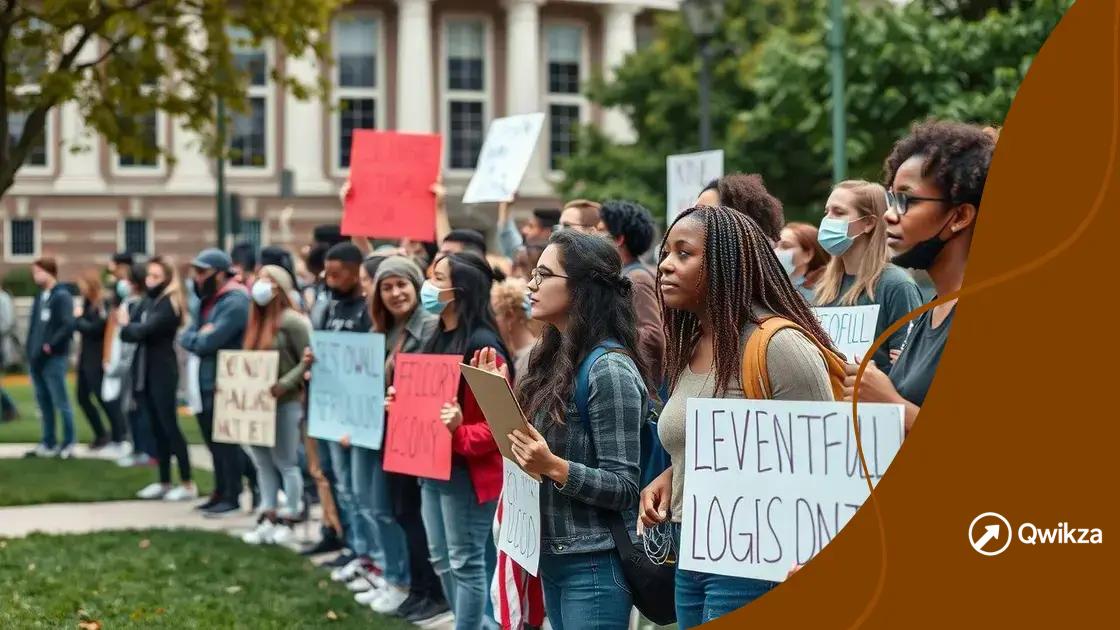Student activism and administrative responses: what’s changing?

Student activism and administrative responses are crucial in shaping educational environments, as effective engagement between students and universities often leads to meaningful social change and improved campus dynamics.
Student activism and administrative responses are increasingly influencing campus dynamics today. Have you noticed how students are taking a stand for change? Let’s delve into this evolving landscape.
Understanding student activism
Understanding student activism is crucial in today’s educational environment. Many students are passionate about social issues and feel the need to voice their opinions. This activism often leads to significant changes within their institutions.
What Drives Student Activism?
Numerous factors motivate students to engage in activism. They often feel strongly about issues such as climate change, racial equality, and mental health awareness. These concerns push them to take action and demand change.
- The desire for social justice
- Awareness of global issues
- The influence of peers and social media
- A need for a voice in governance
Students harness the power of social media to mobilize their peers and raise awareness. They can share information quickly, create events, and invite others to join their causes. This digital platform allows activism to spread beyond the campus. When students unite, they create a stronger impact. Coordinated efforts often lead to larger movements that demand attention from school administrators.
The Role of Universities
Universities play a significant role in shaping the student activism landscape. They can either suppress or support these movements based on policies and responses. Understanding the dynamics between students and administrators is crucial for fostering a positive environment.
Open dialogue between students and administrations can lead to beneficial outcomes. It is essential for universities to listen and respond accordingly, creating an atmosphere where student activism is respected and encouraged.
Through support and acknowledgment, universities can become a space for growth. Students will feel empowered to express themselves and engage in meaningful activism that influences both their campuses and the wider community.
Key strategies used by activists
Activists today use various strategies to amplify their voices and create impact. These tactics not only help raise awareness but also garner support from wider communities. Understanding these approaches is essential for anyone interested in effective student activism.
Grassroots Organizing
One of the most powerful methods used by activists is grassroots organizing. This approach focuses on building a community from the ground up. Many groups start by mobilizing students on campus to join forces and tackle issues together.
- Starting local chapters of larger movements
- Hosting events to unite students
- Creating coalitions with other organizations
- Utilizing social media for outreach
This level of engagement fosters a sense of ownership among participants. When students feel included in decision-making, they are more likely to stay committed to their cause.
Effective Communication
Another key strategy is effective communication. Activists must convey their message clearly to reach a broader audience. This includes using simple language, strong visuals, and engaging stories. Activists often share personal experiences to humanize their cause and create empathy.
Social media plays a significant role here, as it allows activists to connect with supporters quickly. Engaging posts can spark conversations, encourage sharing, and broaden the reach of their message.
By actively engaging the public, student activists can turn a small issue into a larger movement. The more relatable their message, the better the response they receive.
Building Alliances
Collaboration is another strategy that enhances the impact of activism. By partnering with local organizations, nonprofits, and community leaders, students can strengthen their cause. These alliances provide additional resources, skills, and networks to support their initiatives.
Such partnerships also demonstrate the issue’s importance. When a diverse group of people stands together, they show that activism transcends boundaries. In this way, student activists can create a more significant and lasting change.
Responses from university administrations

Responses from university administrations to student activism can greatly influence the effectiveness of these movements. How universities handle protests and demands matters not just to students, but to the entire campus community.
Understanding Administrative Attitudes
Every university has its culture and ways of addressing student activism. Some administrations are open-minded and willing to engage, while others may choose to clamp down. The way they react can affect relationships with students and staff.
When administrators are receptive, it fosters a healthier campus environment. Open discussions can lead to solutions that benefit everyone. However, resistance can lead to frustration and further activism.
Methods of Engagement
Many universities take proactive measures to handle student concerns. These methods can include:
- Creating forums for dialogue between students and administrators
- Establishing clear policies about peaceful protests
- Appointing an ombudsperson to handle grievances
- Offering resources for student-led initiatives
Such approaches can help address issues effectively and respectfully. By engaging students directly, universities can gain valuable insights into their concerns.
Consequences of Inaction
If universities ignore student activism, there can be serious repercussions. Students may feel alienated, leading to a breakdown in trust. This can escalate tensions and inspire greater resistance from the student body.
Moreover, negative administrative responses can damage the university’s reputation. When institutional silence occurs, it can reflect poorly on their commitment to student voices. Implementing supportive measures can mitigate dissent and build trust within the campus community.
The impact of social media
The impact of social media on student activism is profound. Platforms like Twitter, Facebook, and Instagram have transformed how students organize and communicate about important issues. These tools allow for rapid dissemination of information, making activism more accessible than ever.
Mobilizing Support
Social media enables students to quickly mobilize support for their causes. With just a few clicks, activists can reach hundreds or even thousands of people. Events can be created and shared instantly, drawing attention to protests and rallies.
- Rapid sharing of important updates and news
- Creating hashtags to unite movements
- Encouraging participation through live streams
- Connecting with like-minded individuals globally
This immediate access to an audience helps students generate buzz and excitement around their causes. The collective energy can lead to a surge in participation and visibility.
Building Communities
Beyond mobilization, social media also helps build communities. Students can connect with others who share the same goals and values. This sense of belonging can strengthen movements and keep activists motivated.
By sharing personal stories and experiences online, students humanize their causes. This creates a deeper emotional connection with their followers, often encouraging them to take action. Engaging content, such as videos and articles, can resonate widely, spreading awareness even further.
Challenges and Misuse
However, the use of social media in student activism is not without challenges. Misinformation can spread just as quickly as accurate information. Additionally, online harassment can deter students from speaking out.
There’s also the risk of activism becoming performative, where individuals participate for the sake of appearances rather than genuine change. It’s important for students to critically evaluate the messages they see and share on these platforms.
Case studies of successful movements
Examining case studies of successful movements offers valuable lessons in student activism. These examples highlight effective strategies and the potential for change when students unite around a common cause.
The March for Our Lives
One notable example is the March for Our Lives movement. Following the tragic shooting at Marjory Stoneman Douglas High School, students organized a nationwide march advocating for gun control. Their ability to mobilize quickly showcased the power of youth activism.
- Utilized social media to spread awareness rapidly
- Engaged thousands of participants across major U.S. cities
- Successfully lobbied for stricter gun laws in several states
This movement not only changed public opinion but also influenced legislative actions, demonstrating the effectiveness of organized activism.
The Black Lives Matter Movement
Another significant case study is the Black Lives Matter (BLM) movement. Initiated in 2013, BLM has grown into a global movement advocating for racial justice and police reform. The ongoing activism has sparked crucial conversations about systemic racism.
Students played a pivotal role in amplifying BLM’s messages through protests, school walkouts, and social outreach. Their involvement highlighted how youth can drive social change and demand accountability.
Climate Strikes
Inspired by Greta Thunberg, students worldwide have participated in climate strikes, emphasizing the urgent need for climate action. These strikes showed the strength of collective action across borders, resonating deeply with young people everywhere.
- Created a platform for students to express their concerns
- Influenced policies and decisions at local and global levels
- Unified students around environmental sustainability
The impact of these movements illustrates the importance of activism in driving social change. When students collaborate, they can effectively challenge existing norms and bring light to pressing issues.
FAQ – Frequently Asked Questions about Student Activism and Administrative Responses
What is student activism?
Student activism refers to efforts by students to promote social, political, or environmental change. This often includes organizing protests, engaging in advocacy, and raising awareness about issues affecting their communities.
How has social media impacted student activism?
Social media has significantly amplified student activism by allowing for quick information sharing, mobilizing support, and connecting like-minded individuals across the globe.
What can universities do to support student activism?
Universities can support student activism by creating open forums for dialogue, establishing clear policies for protests, and respecting students’ voices and concerns through constructive engagement.
Can student movements lead to real change?
Yes, student movements have historically led to substantial social and legislative changes, as seen in examples like the March for Our Lives and the Black Lives Matter movement.
